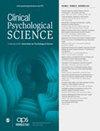抑郁症状及其机制:通过小组网络方法调查长期互动模式
IF 4.1
2区 医学
Q1 PSYCHIATRY
引用次数: 0
摘要
该研究调查了抑郁症状、元认知疗法模型中提出的机制和孤独感之间在 9 个月时间内的动态相互作用。在挪威 COVID-19 大流行期间,4,361 名有代表性的参与者提供了相隔 2 个月的四波数据。使用新开发的面板图形向量自回归方法对网络进行了估算。在时间网络中,使用药物来应对负面情绪或想法对威胁监测和抑郁情绪有正向预测作用。反过来,威胁监测又会正向预测自杀意念。认为思想和情感是危险的元认知信念对失乐症有正向预测作用。自杀倾向与睡眠问题和无价值感呈正相关。孤独感与抑郁情绪呈正相关。反过来,更多的孤独感也预示着更强的情绪控制能力。研究结果表明,威胁监测、认为思想和情感具有危险性的信念以及使用药物来应对等理论衍生变量是缓解长期抑郁症状的潜在干预目标。本文章由计算机程序翻译,如有差异,请以英文原文为准。
Depressive Symptoms and Their Mechanisms: An Investigation of Long-Term Patterns of Interaction Through a Panel-Network Approach
The dynamic interaction between depressive symptoms, mechanisms proposed in the metacognitive-therapy model, and loneliness across a 9-month period was investigated. Four data waves 2 months apart were delivered by a representative population sample of 4,361 participants during the COVID-19 pandemic in Norway. Networks were estimated using the newly developed panel graphical vector-autoregression method. In the temporal network, use of substance to cope with negative feelings or thoughts positively predicted threat monitoring and depressed mood. In turn, threat monitoring positively predicted suicidal ideation. Metacognitive beliefs that thoughts and feelings are dangerous positively predicted anhedonia. Suicidal ideation positively predicted sleep problems and worthlessness. Loneliness was positively predicted by depressed mood. In turn, more loneliness predicted more control of emotions. The findings point at the theory-derived variables, threat monitoring, beliefs that thoughts and feelings are dangerous, and use of substance to cope, as potential targets for intervention to alleviate long-term depressive symptoms.
求助全文
通过发布文献求助,成功后即可免费获取论文全文。
去求助
来源期刊

Clinical Psychological Science
Psychology-Clinical Psychology
CiteScore
9.70
自引率
2.10%
发文量
35
期刊介绍:
The Association for Psychological Science’s journal, Clinical Psychological Science, emerges from this confluence to provide readers with the best, most innovative research in clinical psychological science, giving researchers of all stripes a home for their work and a place in which to communicate with a broad audience of both clinical and other scientists.
 求助内容:
求助内容: 应助结果提醒方式:
应助结果提醒方式:


